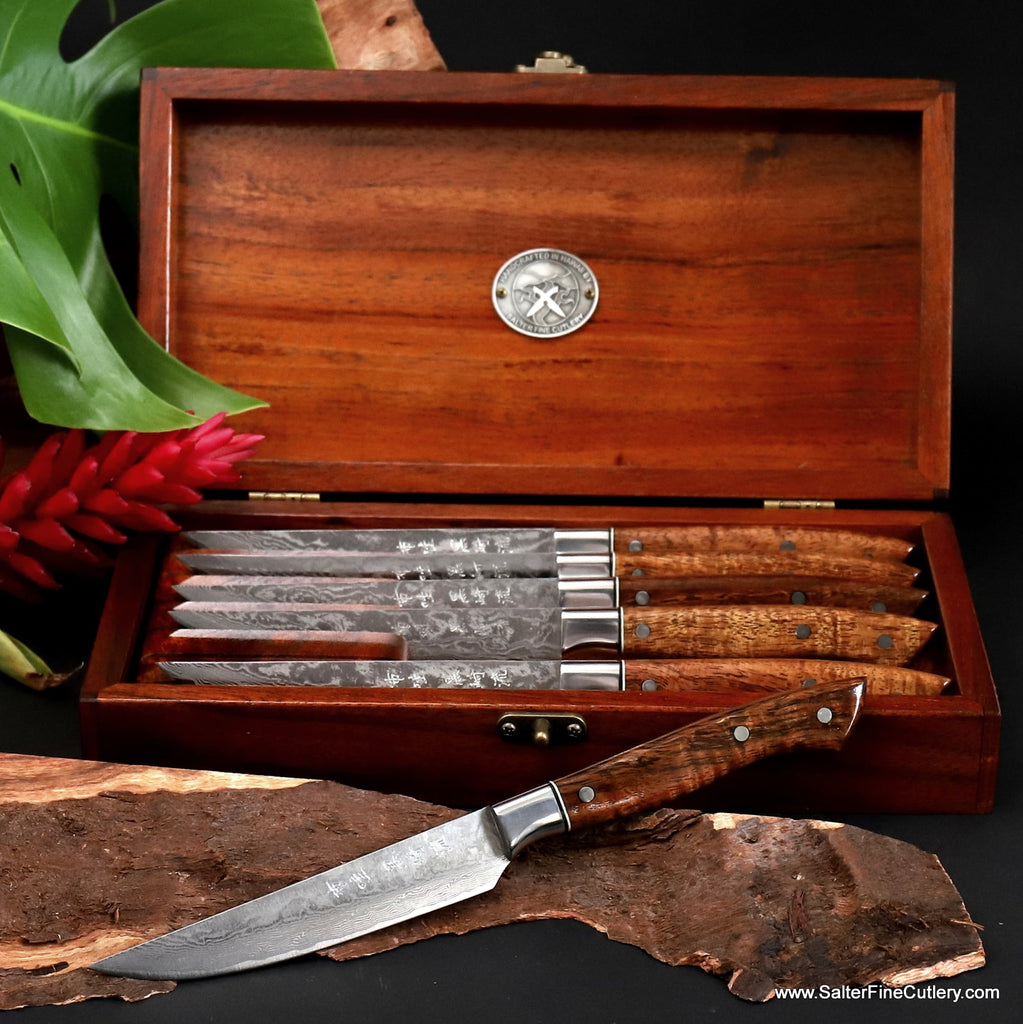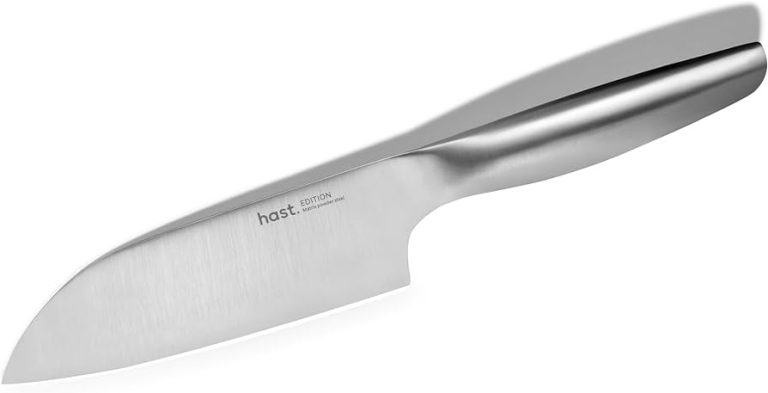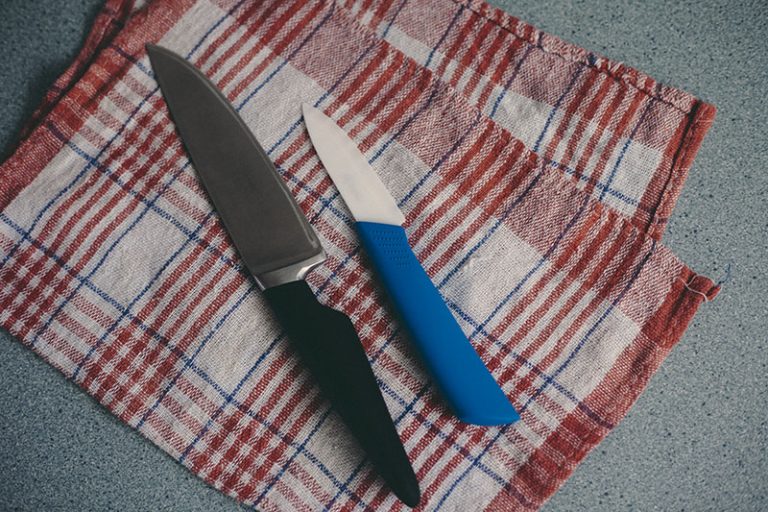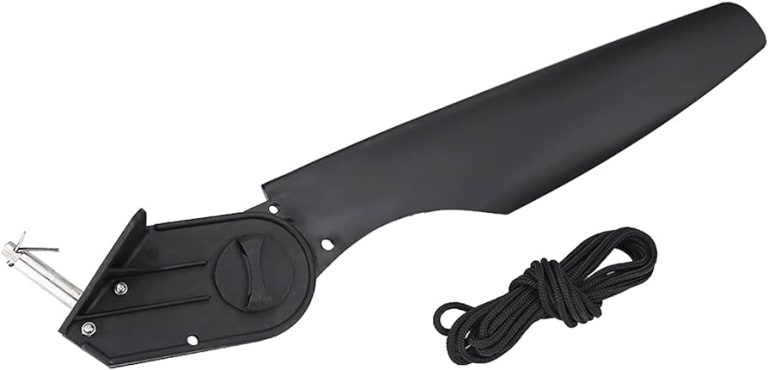The Role of Steak Knives in a Fine Dining Experience
Steak knives play a crucial role in enhancing the experience of fine dining by providing the necessary tools to cut and enjoy steak effortlessly. An elegant and well-designed steak knife enhances the presentation of the dish and ensures that each bite is smooth and enjoyable.
The weight and balance of a quality steak knife enhance the overall dining experience, allowing guests to savor the flavors and textures of their steak without any challenges or frustrations. The sharpness of the blade ensures precise cuts, while the ergonomic handle offers a comfortable grip.
With their contribution to ease and refinement, steak knives elevate a fine dining experience to new heights.
The Anatomy Of A Perfect Steak Knife
Steak knives play a crucial role in elevating the fine dining experience, with their perfect balance and sharpness. Crafted with precision, these knives effortlessly cut through succulent steaks, enhancing every bite. Discover the anatomy of a perfect steak knife and embrace the art of enjoying a steak in style.
Importance Of A Well-Designed Steak Knife In Fine Dining
Steak knives play a significant role in enhancing the overall dining experience, particularly when indulging in a perfectly cooked steak. These well-crafted utensils not only provide a functional purpose but also add an element of elegance to the table setting.
The importance of a well-designed steak knife in the world of fine dining cannot be underestimated. To fully comprehend its significance, let’s delve into the anatomy of a perfect steak knife.
A well-designed steak knife encompasses several factors that contribute to its effectiveness and visual appeal. When considering the ideal steak knife, certain aspects need to be taken into account. Here are some factors to consider when choosing a steak knife:
- Blade Sharpness: The blade of a steak knife should be razor-sharp to effortlessly slice through the meat without tearing or crushing it. A razor-sharp edge ensures a clean cut and preserves the flavorful juices of the steak.
- Ergonomic Handle: The handle of a steak knife should offer a comfortable grip to facilitate precision and control while cutting. An ergonomic handle design prevents hand fatigue and allows for a pleasurable dining experience.
- Balanced Weight: A perfect steak knife strikes a balance between the weight of the blade and handle. This equilibrium ensures optimal maneuverability and control, enabling the user to effortlessly glide through the steak.
- High-Quality Materials: The materials used in the construction of a steak knife significantly impact its performance and durability. Blades made from high-quality stainless steel ensure longevity and resistance to corrosion, while sturdy handles crafted from materials like wood or synthetic materials provide durability and aesthetic appeal.
- Aesthetic Design: Fine dining goes beyond taste; it is also a feast for the eyes. A visually pleasing steak knife, with its elegant and refined design, can elevate the overall dining experience by adding a touch of sophistication to the table setting.
- Maintenance and Durability: Consider the ease of maintenance and durability of the steak knife. Opting for blades that are easy to sharpen and handles that withstand regular use and washing will ensure the knife maintains its quality in the long run.
The importance of choosing a well-designed steak knife cannot be overstated. It not only enhances the culinary experience but also reflects the attention to detail and commitment to excellence in fine dining establishments. A well-constructed steak knife, with its sharp blade, ergonomic handle, balanced weight, high-quality materials, and aesthetically pleasing design, is a testament to the pursuit of perfection.
The Role Of Steak Knives In Enhancing The Dining Experience
Steak knives play a crucial role in elevating the fine dining experience, enhancing both the presentation and enjoyment of a delicious cut of meat. With their sharp blades and ergonomic handles, these specialized knives effortlessly slice through steaks, ensuring each bite is a delightful and satisfying experience.
Perfectly Executing The First Cut
- The first cut of a perfectly cooked steak sets the tone for the entire dining experience. It should be effortless and smooth, allowing the diner to fully enjoy every bite.
How The Sharpness Of The Blade Makes A Difference:
- A sharp steak knife is crucial for a fine dining experience, as it glides through the meat without tearing or crushing it.
- A sharp blade ensures clean cuts, preserving the juices and flavors of the steak.
- It allows for precise control, making it easier to cut through tougher sections or bone-in steaks.
- A sharp knife also reduces the effort required, enhancing the overall dining experience.
The Impact Of A Comfortable Grip On The Overall Experience:
- A comfortable grip on the steak knife guarantees a pleasurable dining experience.
- It allows the diner to maintain control and stability while cutting through the steak.
- A comfortable grip minimizes hand fatigue, ensuring a relaxed and enjoyable meal.
- It enhances safety, reducing the risk of accidental slips or injuries during the dining experience.
Remember, these are just a few aspects that emphasize the role of steak knives in enhancing the dining experience. From the first cut to the comfort of the grip, every detail contributes to creating an unforgettable fine dining experience.
Different Types Of Steak Knives For Different Culinary Styles
Discover the perfect steak knives to enhance your fine dining experience. With a variety of styles available, each tailored to different culinary preferences, you can elevate your steak enjoyment to a whole new level.
In the world of fine dining, a well-cooked steak is a true culinary masterpiece. But what truly sets a remarkable dining experience apart is the attention to detail, even when it comes to the cutlery. Steak knives play a crucial role in ensuring a delightful dining experience, and they come in different styles to cater to various culinary preferences.
Let’s explore the two main categories: traditional steak knives and modern steak knives.
Traditional Steak Knives
Traditional steak knives exude timeless elegance and charm. They are often characterized by their classic designs and simple yet refined aesthetics. Here are some key points to know about traditional steak knives:
- Classic designs and their appeal:
- Straightforward and unassuming, traditional steak knives boast a timeless charm that fits perfectly with any fine dining setup.
- Their elegant handles are often crafted from polished wood or bone, providing a comfortable grip that enhances the dining experience.
- The historical significance of traditional steak knives:
- Traditional designs have a rich history dating back decades, if not centuries, making them an emblem of sophistication and tradition.
- These knives pay homage to traditional craftsmanship, ensuring a sense of authenticity and nostalgia at the dining table.
Modern Steak Knives
In contrast to their traditional counterparts, modern steak knives showcase sleek and stylish designs that complement contemporary dining trends. They not only enhance the visual appeal of a well-plated steak but also offer improved functionality. Here’s what you need to know about modern steak knives:
- Sleek and stylish designs that complement contemporary dining:
- Modern steak knives often feature minimalist designs with smooth lines and streamlined silhouettes, adding a touch of sophistication to the dining experience.
- With their sleek appearance, these knives effortlessly blend in with modern table settings, making them a popular choice in upscale restaurants.
- Incorporating ergonomic features for enhanced performance:
- Modern steak knives prioritize functionality as much as aesthetics. Many models boast ergonomically shaped handles that ensure a comfortable and secure grip, allowing for precise cutting.
- These knives are often crafted from high-quality materials such as stainless steel, ensuring durability and sharpness for a seamless steak-cutting experience.
When it comes to a fine dining experience, the type of steak knife you choose can significantly impact the overall enjoyment of the meal. Whether you prefer the timeless elegance of traditional steak knives or the sleek appeal of modern ones, investing in the right cutlery can elevate your dining experience to new heights.
Choose wisely, and savor every bite.

Credit: salterfinecutlery.com
Maintaining Steak Knives For Longevity And Optimal Performance
Steak knives play a crucial role in enhancing the fine dining experience. To ensure their longevity and optimal performance, proper maintenance is essential. Regular sharpening, hand washing, and proper storage can help preserve the quality of these knives, ensuring they remain sharp and ready for every delicious steak.
A fine dining experience is not just about the quality of the ingredients and the skill of the chef. It is also about the tools used, including the steak knives. Proper maintenance and care of these knives ensure their longevity and optimal performance.
Whether you are a home cook or a professional chef, here are some tips to help you maintain your steak knives:
Proper Cleaning And Storage Techniques:
- Clean your steak knives immediately after each use to prevent the buildup of food particles and stains.
- Use mild dish soap and warm water to clean the blades. Avoid using abrasive scrubbers or harsh chemicals that can damage the blade surface.
- Dry the knives thoroughly before storing them to prevent moisture from causing rust or corrosion.
- Store your steak knives in a knife block, knife tray, or a knife roll to protect the blades and prevent them from coming into contact with other utensils that could dull their edges.
Avoiding Damage And Maintaining The Blade’S Sharpness:
- Avoid using the steak knives on hard surfaces such as ceramic plates or cutting boards made of glass or stone, as this can damage the blades.
- Always use a cutting board made of wood or plastic to protect the knife’s edge.
- Do not use the knives to pry open containers or for any other purpose other than cutting steak.
- Be cautious when handling the knives, especially when passing them to others or when washing them, to prevent accidental drops and damage to the blade or handle.
Regular Sharpening And Honing:
- Regularly sharpen your steak knives to maintain their cutting performance. Use a sharpening stone or a knife sharpener specifically designed for steak knives.
- Honing the knives with a honing steel before each use will help realign the blade edges and keep them sharp.
- Seek professional sharpening services or learn to sharpen the knives yourself if you are confident in your skills. Proper sharpening ensures a consistent cutting edge for a smooth and effortless slicing experience.
The Importance Of Routine Maintenance For A Pristine Cutting Edge:
- Routine maintenance is crucial to keep your steak knives in top condition and ensure a pristine cutting edge.
- By following proper cleaning, storage, and knife care techniques, you can enhance the lifespan of your knives and maintain their optimal performance.
- Regularly inspect your knives for any signs of wear or damage, such as chips or bent blades. Replace any damaged knives promptly to prevent accidents during use.
By giving your steak knives the attention they deserve through proper maintenance, you can uphold their longevity, sharpness, and overall performance, enhancing your fine dining experience with every cut.
Choosing The Perfect Steak Knife For Every Occasion
Steak knives play a pivotal role in enhancing the fine dining experience, offering precision cutting and effortless slicing. With a wide range of options available, choosing the perfect steak knife tailored to each occasion ensures an unforgettable meal.
When it comes to enjoying a fine dining experience, the role of steak knives cannot be overlooked. These essential tools not only serve a functional purpose but also add a touch of elegance to the overall dining aesthetic. Whether you’re hosting a dinner party or simply indulging in a delicious steak at home, selecting the ideal steak knife is crucial.
In this section, we will explore the factors to consider when choosing the perfect steak knife, balancing form and function, the importance of handles that match the dining aesthetic, and the pros and cons of steak knife sets versus individual knives.
Factors To Consider When Selecting The Ideal Steak Knife:
- Blade quality: Look for high-quality stainless steel blades that are sharp, durable, and resistant to rust.
- Blade shape: Opt for a serrated or straight-edge blade, depending on your personal preference and the type of meat you will be cutting.
- Blade length: Consider the length of the blade, ensuring it is long enough to effortlessly cut through thick steaks.
- Handle material: Choose a handle material that provides a comfortable grip and complements the overall dining aesthetic.
- Handle construction: Look for handles that are securely attached to the blade for optimal stability and balance.
Balance Between Form And Function:
- Consider the overall design and style of the steak knife, ensuring it matches the overall dining experience and the table setting.
- Keep in mind that while aesthetics are important, the knife should also provide a comfortable grip and facilitate easy cutting.
Handles That Match The Dining Aesthetic:
- Wood: Offers a warm and traditional feel, perfect for rustic or classic dining settings.
- Stainless steel: Provides a sleek and modern look, ideal for contemporary or minimalist dining spaces.
- Bone or horn: Adds a touch of elegance and sophistication, often found in upscale or formal dining establishments.
Steak Knife Sets Vs. Individual Knives:
Steak knife sets:
- Convenience: Sets typically come with a storage block or case, keeping the knives organized and readily accessible.
- Matching aesthetic: Sets guarantee that all knives have a cohesive design, creating a visually appealing table setting.
- Variety: Sets often include different styles or sizes of steak knives, allowing for versatility when serving different cuts of meat.
Individual knives:
- Customization: With individual knives, you have the freedom to select the exact style, material, and design that suits your preferences.
- Quality: Investing in individual high-quality steak knives ensures each knife is carefully crafted and built to last.
- Budget-friendly: Purchasing individual knives can be a more cost-effective option, especially if you only need a few for personal use.
Remember, selecting the perfect steak knife involves finding a balance between functionality and aesthetic appeal. Consider the factors mentioned above, such as blade quality, handle material, and overall design, to elevate your dining experience and impress your guests.
The Future Of Steak Knives In Fine Dining
Steak knives play a pivotal role in elevating the fine dining experience. With their sharpness and precision, these knives ensure effortless cutting and enhance the enjoyment of indulging in a perfectly cooked steak. The future of steak knives in fine dining looks promising, as they continue to be an essential tool for both chefs and diners alike.
In the ever-evolving world of fine dining, even the smallest details can make a significant impact on the overall experience. Steak knives, once seen as nothing more than utilitarian tools, are now being given the attention they deserve. As chefs and restaurateurs strive for perfection, the future of steak knives in fine dining is taking shape with emerging trends, innovative materials and technologies, an evolving role in modern gastronomy, and unconventional presentations and new dining experiences.
Emerging Trends In Steak Knife Design:
- Streamlined and minimalist designs are becoming increasingly popular, with sleek handles and sharp, precision blades.
- Customization options are becoming more common, allowing chefs to personalize their steak knives to match the décor and theme of their restaurant.
- Sustainable and eco-friendly materials such as bamboo and recycled steel are gaining traction, aligning with the growing demand for environmentally conscious dining experiences.
Innovative Materials And Technologies:
- High-quality stainless steel remains a staple in steak knife construction, as it ensures durability and sharpness.
- However, new materials like ceramic and carbon fiber are gaining attention for their lightweight properties and exceptional cutting ability.
- The integration of technology, such as ergonomic handle designs and self-sharpening mechanisms, is enhancing the functionality and usability of steak knives.
The Evolving Role Of Steak Knives In Modern Gastronomy:
- Steak knives are no longer reserved solely for steaks. Chefs are incorporating them into various dishes, allowing patrons to enjoy a range of meats and textures with ease.
- These knives are now considered culinary tools that enhance the dining experience, providing guests with the opportunity to interact with their food on a more personal level.
- The versatility of steak knives is expanding as they are utilized in creative ways, such as for precision slicing of delicate ingredients or as an accompaniment to shareable small plates.
Unconventional Presentations And New Dining Experiences:
- Restaurateurs are pushing boundaries by presenting steaks pre-cut and elegantly plated, eliminating the need for guests to use steak knives altogether.
- Some establishments are exploring unique dining concepts, such as interactive grill experiences, where patrons are encouraged to cook their own steak at the table, using specialty knives designed specifically for this purpose.
- In avant-garde dining experiences, steak knives may be replaced with alternative tools, further blurring the lines between cutlery and art.
As the culinary landscape evolves, so too does the role of steak knives in fine dining. From their design and materials to their usage and presentation, these humble tools are becoming integral elements in creating unforgettable experiences for gastronomy enthusiasts.
With emerging trends, innovative materials and technologies, an evolving role, and unconventional presentations, the future of steak knives is a testament to the dedication of chefs and restaurateurs to elevate every aspect of the fine dining journey.
Frequently Asked Questions Of The Role Of Steak Knives In A Fine Dining Experience
Why Is Steak Knife Important?
Steak knives are important because they cut through tough meat easily and provide a better dining experience.
What Is The Difference Between A Steak Knife And A Dinner Knife?
A steak knife is used for cutting steak, while a dinner knife is used for general dining.
What Is The Meaning Of Steak Knife?
A steak knife is a sharp utensil used specifically for cutting and eating steak.
Do You Need Steak Knives?
Yes, steak knives are essential for cutting through steaks and other meats effectively.
Conclusion
Steak knives play a crucial role in enhancing the fine dining experience. These specialized knives, with their sharp and serrated blades, are designed to effortlessly cut through even the toughest cuts of meat. By providing diners with the proper tool for the job, restaurants can ensure that their guests can fully enjoy their meal without struggling with tough or unappetizing meat.
Furthermore, the presence of steak knives signals a level of sophistication and attention to detail in a dining establishment, adding to the overall ambiance and luxury of the dining experience. From the moment the steak knife is placed on the table, anticipation builds, and the moment the first bite is taken, the dining experience is elevated.
So whether you’re a foodie looking for the perfect steakhouse or a restaurant owner aiming to impress, never underestimate the important role that steak knives play in creating an exceptional fine dining experience.






